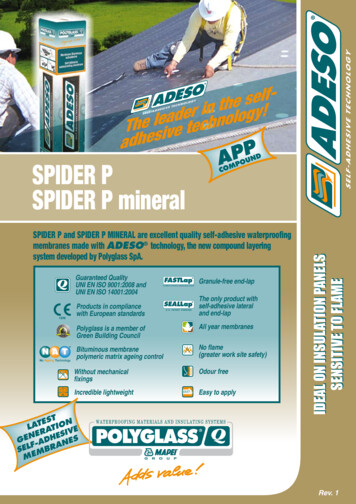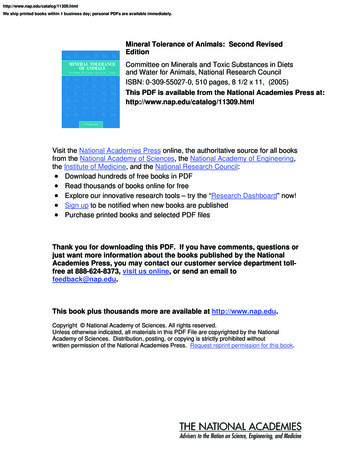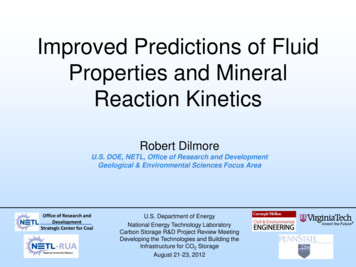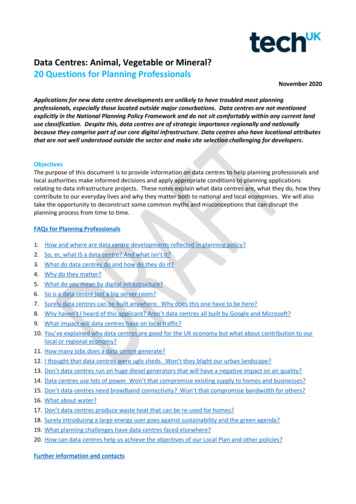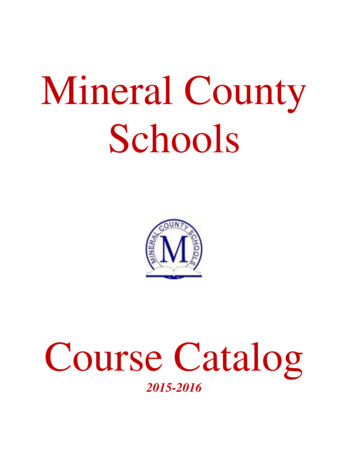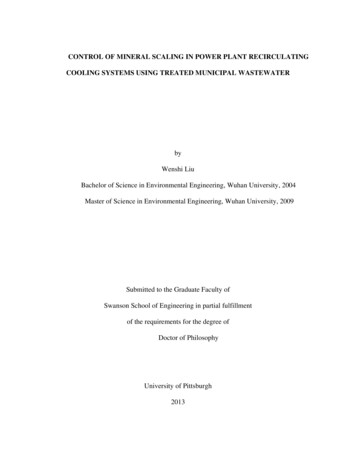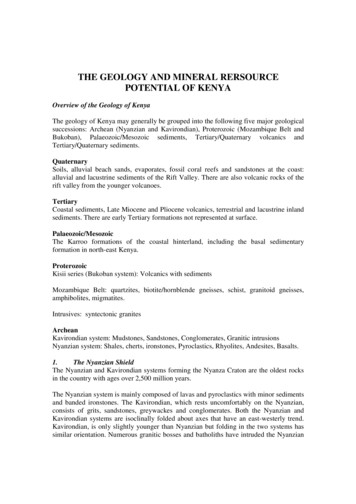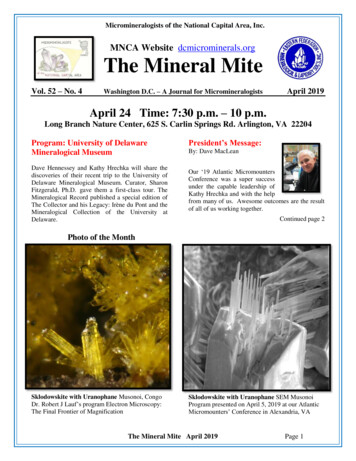
Transcription
Micromineralogists of the National Capital Area, Inc.MNCA Website dcmicrominerals.orgThe Mineral MiteVol. 52 – No. 4Washington D.C. – A Journal for MicromineralogistsApril 2019April 24 Time: 7:30 p.m. – 10 p.m.Long Branch Nature Center, 625 S. Carlin Springs Rd. Arlington, VA 22204Program: University of DelawareMineralogical MuseumPresident’s Message:Dave Hennessey and Kathy Hrechka will share thediscoveries of their recent trip to the University ofDelaware Mineralogical Museum. Curator, SharonFitzgerald, Ph.D. gave them a first-class tour. TheMineralogical Record published a special edition ofThe Collector and his Legacy: Irène du Pont and theMineralogical Collection of the University atDelaware.Our ‘19 Atlantic MicromountersConference was a super successunder the capable leadership ofKathy Hrechka and with the helpfrom many of us. Awesome outcomes are the resultof all of us working together.By: Dave MacLeanContinued page 2Photo of the MonthSklodowskite with Uranophane Musonoi, CongoDr. Robert J Lauf’s program Electron Microscopy:The Final Frontier of MagnificationSklodowskite with Uranophane SEM MusonoiProgram presented on April 5, 2019 at our AtlanticMicromounters’ Conference in Alexandria, VAThe Mineral Mite April 2019Page 1
Micromineralogists of the National Capital Area, Inc.President’s Message continuedWe found out from Dr. Robert Lauf the power ofelectron microscopy, the variety of colorful uraniumand thorium minerals, ortho silicates and fromMichael Pabst the wonders of lanthanide (rare earth)minerals. Herwig Pelckmans showed us how toobtain more info out of Google and Mindat. Theauction was one of the liveliest in several years, withlots of eager and aggressive bidding for attractiveminerals.Previous Meeting Minutes: 3/27/18By Bob Cooke, SecretaryFair. Dave will ask Robert Clemenzi for advancedschedule information on next year's show so thatMNCA can consider participation in the 2020 event.Kathy Hrechka provided an update on the AtlanticMicromounters’ Conference (AMC) for April 5 &6. Setup will begin at 4 PM on Friday. Al Pribulaand Barbara Sky will be vendors. The grouprecommended Dr. Michael Seeds be considered as aguest speaker for the 2020 AMC. The meetingadjourned at 8:40 PM.Previous Program Reviewed: 3/27/19By Bob Cooke, SecretaryPresident Dave MacLean called themeeting to order at 7:45 PM March27, 2019. No past presidents orguests were present. Nine MNCAmembers were present.Minutes of the February 2019 meeting were approvedas printed in the Mineral Mite. Members discussedthe passing of Carolyn Weinberger and approved adonation of 100 to the Leukemia and LymphonaSociety in her honor. Kathy Hrechka and DaveFryauff will represent MNCA at her funeral.Program: Cornish Mineral Legacy by Dr. RobertBowell - Dr. Robert Bowell was a featured speaker atthe Dallas Mineral Collecting Symposium in August2018. The theme for the symposium was history ofmineral mining and collecting. Cornwall has been(and currently is remerging as) an active center ofhard rock mining for more than 4,000 years. Thispresentation will explore the legacy of “Cousin Jack”(as Cornish miners were called) and the richinheritance associated with the country.Mineral Collecting Field Trip Note:Erich Grundel suggested MNCA consider a digitalmicroscope to replace, or at least augment, the opticalmicroscopes currently used at MNCA demonstrationevents. Kathy Hrechka and Germain Broussardagreed to bring their digital microscopes to the nextmeeting so members could evaluate thetechnology. Michael Pabst mentioned the option ofviewing minerals via a DSLR camera connected to alaptop computer.Dave Fryauff announced a collecting field trip toVulcan Manassas Quarry on March 30 at 7:30AM. Dave is in the process of scheduling a trip toNational Limestone Quarry for mid-April and willemail details to members. He also discussed theSuper Dig at Franklin, New Jersey on April 27/28.Dave MacLean asked members if there was anyinterest in hosting an MNCA demonstration table atthe GMU Maker Fair in June. There was onlymarginal support for the demonstration table andmembers agreed not to participate in this year's MakerBy David FryauffWe are booked for the National Limestone #1(Middleburg) & #2 (Mount Pleasant Mills)quarries in Snyder Co. PA on Saturday, June 29that 9 am in the Middleburg quarry office. Theseare popular and welcoming quarries and EFMLSclubs throughout the east coast have bookedvirtually all the other Saturdays in April, May,and June.Need I mention that these quarries are greatplaces to collect both minerals and fossils. TheWavellite pit at Mount Pleasant Mills is one ofthe best sites in PA for the collection ofphosphate minerals, but they are generally of asize loved only by micromounters.The Mineral Mite April 2019Page 2
Micromineralogists of the National Capital Area, Inc.Atlantic Micromounters’ ConferenceApril 5-6, 2019 SuccessSpeaker, Dr. Robert Lauf of TennesseeAuthor, Robert Lauf holds a Ph.D. inMetallurgical Engineering from theUniversity of Illinois. His scientific careerincluded over twenty years at Oak RidgeNational Laboratory, where he conductedresearch on topics ranging from nuclearfuel, coal by-products, icalmaterials,andbiomineralization. He has been grantedfifty U.S. Patents for his inventions, many of whichhave become successful industrial products. He isnow a Registered Patent Agent and technologyconsultant.Hubeite from Hubei, China: While at Oak RidgeNational Laboratory, he received samplesof an unknown mineral assemblage froma new find in China. The Rocksmiths acquired it and wanted to know what itwas. Microanalysis and XRD indicated itto be a new mineral. Jaye Smith had alsosent pieces to several other folks. All involved collaborated on the description ofhubeite, which was published in The Mineralogical Record, volume 33, NovemberDecember 2002. A sample of hubeite fromHubei, China originally studied alongwith a signed copy of the article was offered in the live auction at the conference.Dr. Lauf’s topics included:1. Electron Microscopy: The Final Frontierof Magnification2. Mineralogy of Uranium and Thorium3. Orthosilicates.Polarizing Adaptor for the Stereo Microscope: Dr.Lauf wrote an article about optical Mineralogy, whichfeatured a Motic polarizing kit to be used with a stereomicroscope. He revealed that this device is useful forthin section, as well as sand grain analysis. He alsostated, “the use of this low-cost polarizing kit canopen up a lot of interesting possibilities for themineral collector to use the tools of opticalmineralogy to gain insights into his or hercollections.” His article was featured in MineralNews volume 31, April 2015 published by TonyNickischer of Excalibur Minerals.Graphite from Ticonderoga, New York: Dr. Laufvisited the Lead Hill mine and recovered a variety ofspecimens, particularly graphite single crystals inmarble. These were of interest for radiation damagestudies, which led him to write an article for The Mineralogical Record, volume 14, January-February1983. He provided the publication along with Ticonderoga graphite from New York.Cuprosklodowskite Musonoi, CongoThe Mineral Mite April 2019Page 3
Micromineralogists of the National Capital Area, Inc.Michael Pabst PhD of Virginia presented RareEarth Minerals on Saturday evening.Grossular v hessonite Calexico, CABastnesite Zagi Mountain in Pakistan, FOV 60 mm.For sale 12,500 at 2019 Tucson ShowTopaz w fluorite and hematite Thomas Range, UTZircon is from Rutherford Mine, AmeliaCourthouse, VA, FOV 3 mm, Duresky specimen.The previous four mineral photos were featuredamongst Dr. Lauf’s conference talks.The Mineral Mite April 2019Page 4
Micromineralogists of the National Capital Area, Inc.Joaquinite San Benito County in California, FOV 2mm. Pabst specimen, also has Benitoite andNeptunite.Conference PhotosOn behalf of the Micromineralogists of the NationalCapital Area club members, we thank Dr. Robert J.Lauf along with our 2019 attendees for a successfulconference. We appreciate Dr. Michael Pabst forpresenting “Rare Earth Minerals”. HerwigPelckmans saved the day by bringing chocolates fromAntwerp, Belgium.Thank you, Kathy Hrechka, Conference ChairThe Mineral Mite April 2019Page 5
Micromineralogists of the National Capital Area, Inc.Erich Grundel, Legacy MNCAIn the Fall of 1979, a chance encounter with Dr. LanceKearns at James Madison University led to yearlyfield trips to JMU. Also, as treasurer of theMineralogical Society of the District of Columbia, Isaw to it that JMU students would receivescholarships from the Foshag fund. Other clubs havefollowed in our footsteps.Carolyn WeinbergerBy David Nock,EFMLS PresidentDear EFMLS Rockhound Family,Carolyn went to join our fellow Rockhounds in thatgreat collecting field in the sky, early Mondaymorning, 3/25/19.In the 1970's and 80's I led MNCA field trips to newmineral locations I had discovered. Among themwere Sugar Grove, West Virginia; Buck Hill,Virginia; some long-abandoned Virginia manganesemines and others. I've also discovered new locationsin other places in North America. All these locationsare still viable, and some are still being activelyinvestigated by members, such as Tom Tucker, andothers. These places are known to collectorsthroughout the world thanks to lectures and publishedarticles.It's with great sadness that I inform you that our"Queen of the EFMLS," Carolyn Weinberger haspassed away. She finally succumbed to her multiyear battle with her disease. Carolyn's passion formost and especially the latter part of her life wasrunning our Federation. A giant hole now looms inour extended Rockhound Family. She truly gave usher full-time effort. Carolyn was our foremostadvocate (and our extended family of the AmericanFederation of Mineralogical Societies) of our hobbyand was our EFMLS News newsletter Editor for Idon't know how many years. A lot of years.I've also been a tinkerer. I have several homemadegadgets for micromounting. Among them are acontinuously rotating viewing stage; a device formounting sub-millimeter specimens; and variouspedestal holders in lieu of growing a third arm.On March 25, 2019, Carolyn Weinberger (neeMayer); beloved wife of Steven Weinberger; dearsister-in-law of Marshall and Marcia Klein; cherisheddaughter of the late Hilde and George Mayer; alsosurvived by Robert Levi, a dear cousin.Early on I advocated for using cell phones formicroscopy and photography of microminerals.Currently I am investigating, with the help of MNCAmembers, using digital microscopes for oureducational outreach. Over the 60 years I have beena collector I have accumulated an unwieldy horde ofmaterial. Slowly I have been giving it away and, nowand then, adding a new specimen to my collection.Services were held at SOL LEVINSON & BROS.,INC., 8900 Reisterstown Road, at Mount WilsonLane on Friday, March 29, at 1 pm. IntermentBaltimore Hebrew Cemetery - Berrymans Lane.Contributions in her memory may be sent toLeukemia & Lymphoma Society, 100 Painters MillRoad, Suite 800, Owings Mills, MD 21117.The Mineral Mite April 2019Page 6
Micromineralogists of the National Capital Area, Inc.Rhodonite and PyroxmangiteBy Michael Pabst PhD, TreasurerWe are back to pink manganeseminerals with Rhodonite Mn2 SiO3and its polymorph PyroxmangiteMn2 SiO3. (The readers of thiscolumn will not confuse the silicateRhodonite with the carbonateRhodochrosite Mn2 CO3, which we have alreadyexamined.) Rhodonite is triclinic pinacoidal, meaningthat it has no right angles and only one pair ofsymmetrical faces. At least in many micromountspecimens, the crystals tend to be thin and fragile, sofinding an esthetic complete crystal to photograph isdifficult.There is a polymorph of Rhodonite calledPyroxmangite, also Mn2 SiO3. They are bothtriclinic-pinacoidal with similar parameters, and Ibelieve they can only be distinguished by x-raydiffraction, or by a guess based on locality. There aresome beautiful crystals of Pyromangite, but, alas, Idon’t (knowingly) have one in my collection. Here,from Mindat, is a photo of Pyroxmangite from aclassic locality in Japan: www.mindat.org/photo332225.html.Rhodonite and Pyrite, San Martin Mine, Chiurucu,Huallanca District, Bolognesi Province, AncashDept., Peru.FOV 1 mm. Photo by Michael Pabst. Stack of 7photos taken with stereomicroscope.Here below is a less magnified view of part of theRhodonite from Peru, to acquaint you with the firstimpression you get looking at this specimen beforehigh magnification:Beautiful, cherry-red, blocky crystals of Rhodoniteare found at Broken Hill, New South Wales,Australia. I have often passed up Rhodonitespecimens from Broken Hill, because they were toodamaged in the process of revealing them in massiveGalena or other matrix to pass microscopicobservation, but I wish I had bought this one, picturedon Mindat: www.mindat.org/photo-20974.html.One of the most famous Rhodonite localities is theSan Martin Mine in Peru. Here is an example g down to a micromount, I present the nextphoto, which is a specimen of Rhodonite and Pyritefrom the San Martin Mine.***********In the next article, I will present two more blackmanganese oxide minerals, Chalcophanite andHollandite, which will complete the table ofmanganese oxide minerals in my article on Pyrolusiteand Manganite in the February 2019 Mineral Mite.Rhodonite from San Martin Mine, Peru. Lessmagnified, FOV 15 mm. Photo by Michael Pabst.Stack of 13 photos taken with Olympus 60 mm macrolens.The Mineral Mite April 2019Continued next pagePage 7
Micromineralogists of the National Capital Area, Inc.Here is a tiny Rhodonite from Italy in my micromountcollection:Rhodonite, Valgraveglia Mine (Gambatesa Mine),Monte Copello, Reppia, Genova Province, Liguria,Italy. FOV 1 mm. Photo by Michael Pabst. Stack of4 photos taken with stereomicroscope.Next are two photos of two specimens of Rhodoniteand Andradite garnet from Franklin, New Jers
Services were held at SOL LEVINSON & BROS., INC., 8900 Reisterstown Road, at Mount Wilson Lane on Friday, March 29, at 1 pm. Interment Baltimore Hebrew Cemetery - Berrymans Lane. Contributions in her memory may be sent to Leukemia & Lymphoma Society, 100 Painters Mill Road, Suite 800, Owings Mills, MD 21117. Micromineralogists of the National Capital Area, Inc. The Mineral Mite April 2019

